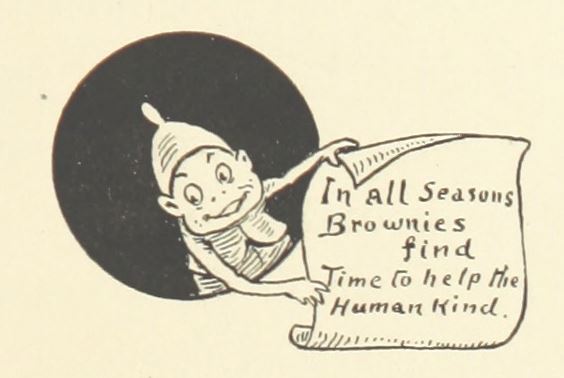Skrats and How to Make Them

Skrats and How to Make Them Not a Skrat, but a Palmer Cox Brownie with a sign stating the Brownie creed. 1893, The British Library
As someone who loathes housework, I have to say I’m enchanted by the idea of helpful domestic spirits. A simple bowl of milk or millet set out for the creature-behind-the-stove and hey presto! the laundry is done and the sink and counters are sparkling!
If only.
I’ve written before about a helpful spirit who bound himself to a French noble, as reported by Froissant. Today we go to the far north to learn how to make and keep a skrat.
SKRATS, AND HOW TO MAKE THEM.
In classic ages Egypt was supposed to be the land of spells and enchantments, but in later days the north was the great repository of such dark acts. Lapland and Finland were famed for their witches, and Norse mythology is rich in tales of charmed swords and mystic spells, and such superstitious fancies. The Swedes and Esthonians still believe in the existence of a mysterious creature called a skrat, a kind of northern Robin Godfellow or household fairy, who will do a great deal of hard work for his owners and only expect a meal in return. Unlike poets, skrats can be made as well as born. A very efficient skrat can be manufactured out of a tin pipe, a bit of tow, part of a pair of scales, part of a harrow, and some other ingredients. This figure must be set up on three successive Thursday nights in the middle of a cross-way, with many ceremonies; and on the last night the skrat manufacturer cuts his finger and allows the blood to fall on the figure, which immediately becomes endowed with life. The manufacturer must have provided a swift horse for himself and a slow one for the skrat, as it is very important that he should succeed in outriding the figure. If he gains his house door first he has secured a humble slave in the skrat. Skrats will do the work of three servants, they guard the house against thieves; they even steal for their owners, bringing food, vegetables, money, if required. They assume various shapes, sometimes that of a man, sometimes of a cat with a fiery tail, sometimes a flea. In 1846, two fishermen returning home along the shores of the Gulf of Riga, saw a skrat sailing through the air in the shape of a fiery dragon. A woman at Hapsal kept a skrat in a box, and used it as a lamp to illuminate the house. Like Scotch brownies, skrats are particular about their food being regularly supplied, and resent any neglect. A skrat in Esthonia, whose comfort was systematically trifled with, revenged himself by burning down the house. Useful as is a skrat, it is highly inexpedient to die with one in your possession; and as it is not to be got rid of at will, it is advisable to begin the necessary process at the first approach of illness or age. A skrat can be dismissed by certain incantations practised at the place of its original creation, or it may be torn in small pieces, and laid in newly-melted ice in the spring. Straws laid crosswise on a doorway will keep away a skrat if its services are not desired.—The Globe.
The Spiritualist Newspaper, 1881
Those are rather frustratingly inadequate directions for creating an artisanal brownie from skratch. A diagram and an Allen wrench would have been helpful.
Considering all the services they offer, I suppose skrats have a right to be particular about their food. They like comfort foods: porridge, millet gruel, milk, cream, and honey. There are variations on the skrat throughout the Germanic and Slavic worlds with names like Schratt, with the appearance of a small boy; and Skrata or Skriatek, which looked like a “drenched chicken.” They all seem to be connected with the luck of the household, ensuring money and food will never be lacking.
Given how pervasive these covert personal assistants were in Europe and the British Isles, why did they, like so many fairies, fail to make the journey to the New World? Domestic spirits seem to be entirely lacking in the United States. Was there a problem with customs? Is there a dusty waiting room somewhere on Ellis Island, full of skrats, Schratts, and brownies, smoking, drinking milk, and playing penny ante poker while they wait to be released or deported?
And if you know precisely how to build a skrat out of tin pipe, tow, etc. as well as what those “other ingredients” might be, I and my household would be grateful if you would share your knowledge: chriswoodyard8 AT gmail.com
Chris Woodyard is the author of The Victorian Book of the Dead, The Ghost Wore Black, The Headless Horror, The Face in the Window, and the 7-volume Haunted Ohio series. She is also the chronicler of the adventures of that amiable murderess Mrs Daffodil in A Spot of Bother: Four Macabre Tales. The books are available in paperback and for Kindle. Indexes and fact sheets for all of these books may be found by searching hauntedohiobooks.com.
